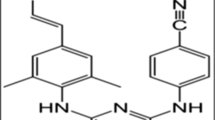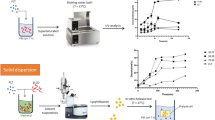Abstract
Nanosponges are betacyclodextrins crosslinked with carbonate bonds. The polymer formed is nanoparticulate in nature. Itraconazole is a BCS Class II drug that has a dissolution rate limited poor bioavailability. Rationale of the work was to enhance the solubility of Itraconazole so that the bioavailability problems are solved. Solid dispersion technique has been used for drug incorporation. The effect of a ternary component copolyvidonum on solubility of itraconazole has been studied. Phase solubility studies has been carried out with a rationale of comparing the solubilization efficiency of nanosponges, copolyvidonum and combination. The dispersions were characterized by differential scanning calorimetry (DSC), powder X-ray diffraction (PXRD) and photon correlation spectroscopy (PCS). It was found that the solubility of itraconazole was enhanced more than 50-folds with a ternary solid dispersion system. Using copolyvidonum in conjunction with nanosponges helps to increase the solubilization efficiency of nanosponges as evident from the phase solubility studies.








Similar content being viewed by others
References
Szejtli, J.: Introduction and general overview of cyclodextrin chemistry. Chem. Rev. 98, 1743−1754 (1998)
Rekharsky, M.V., Inove, Y.: Complexation thermodynamics of cyclodextrins. Chem. Rev. 98, 1875–1918 (1998)
Connors, K.A.: The stability of cyclodextrin complexes in solution. Chem. Rev. 97, 1325–1358 (1997)
Rossi, S., Ferrari, F., Bonferoni, M.C., Caramella, C.: Characterization of chitosan hydrochloride–mucin interaction by means of viscosimetric and turbidimetric measurements. Eur. J. Pharm. Sci. 10, 251–257 (2000)
Trotta, F., Wander, T.: Cross-linked polymers based on cyclodextrins for removing polluting agents. World patent number WO 03/ 085002 (2003)
Peeters, J., et al.: Characterization of the interaction of 2-hydroxypropyl-β-cyclodextrin with itraconazole at pH 2, 4, and 7. J. Pharm. Sci. 91(6), 1414–1422 (2002)
Rambali, B., Verreck, G., Baert, L., Massart, D.L.: Itraconazole formulation studies of the melt-extrusion process with mixture design. Drug Dev. Ind. Pharm. 29(6), 641–652 (2003)
Loftsson, T., Brewster, M.E.: Pharmaceutical applications of cyclodextrins I. drug solubilization and stabilisation. J. Pharm. Sci. 85, 1017–1025 (1996)
Loftsson, T., et al.: Cyclodextrin solubilization of the antibacterial agents triclosan and triclocarban: formation of aggregates and higher-order complexes. Int. J. Pharm. 297, 213–222 (2005)
Patel, A.R., Vavia, P.R.: Effect of hydrophilic polymer on solubilization of fenofibrate by cyclodextrin complexation. J. Incl. Pheno. Macro. Chem. 56, 247–251 (2006)
Higuchi, T., Connors, K.: Phase solubility techniques. In: Reilly, C. (ed.) Advances in Analytical Chemistry and Intrumentation, pp. 117–212. Wiley Interscience, NewYork (1965)
Author information
Authors and Affiliations
Corresponding author
Rights and permissions
About this article
Cite this article
Swaminathan, S., Vavia, P.R., Trotta, F. et al. Formulation of betacyclodextrin based nanosponges of itraconazole. J Incl Phenom Macrocycl Chem 57, 89–94 (2007). https://doi.org/10.1007/s10847-006-9216-9
Received:
Revised:
Accepted:
Published:
Issue Date:
DOI: https://doi.org/10.1007/s10847-006-9216-9




